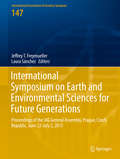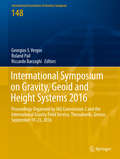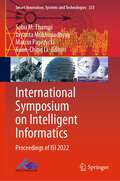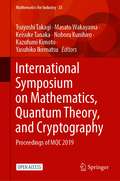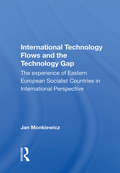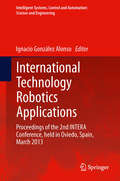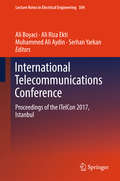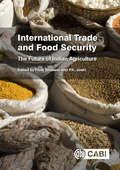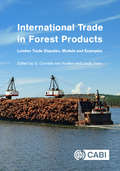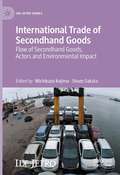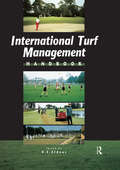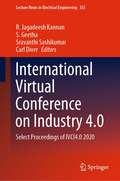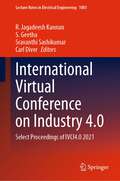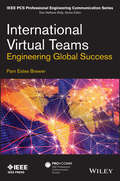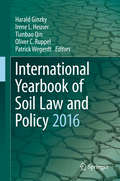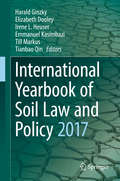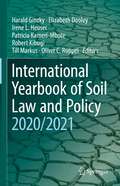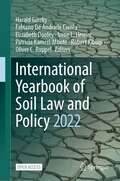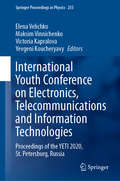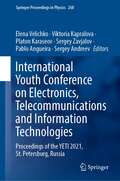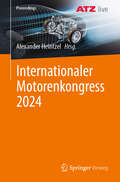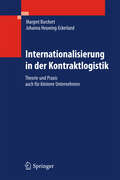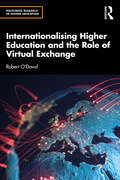- Table View
- List View
International Symposium on Earth and Environmental Sciences for Future Generations: Proceedings of the IAG General Assembly, Prague, Czech Republic, June 22- July 2, 2015 (International Association of Geodesy Symposia #147)
by Jeffrey T. Freymueller Laura SánchezThis book series is composed of peer-reviewed proceedings of selected symposia organized by the International Association of Geodesy. It deals primarily with topics related to Geodesy Earth Sciences : terrestrial reference frame, Earth gravity field, Geodynamics and Earth rotation, Positioning and engineering applications.
International Symposium on Gravity, Geoid and Height Systems 2016: Proceedings Organized by IAG Commission 2 and the International Gravity Field Service, Thessaloniki, Greece, September 19-23, 2016 (International Association of Geodesy Symposia #148)
by Roland Pail Riccardo Barzaghi Georgios S. VergosThese proceedings contain 27 papers, which are the peer-reviewed versions of presentations made at the International Association of Geodesy (IAG) symposium “Gravity, Geoid and Height Systems 2016” (GGHS2016). GGHS2016 was the first Joint international symposium organized by IAG Commission 2 “Gravity Field”, the International Gravity Field Service (IGFS) and the GGOS Focus Area “Unified Height System”. It took place in Thessaloniki, Greece, in September 19-23, 2016 at the premises of the Aristotle University of Thessaloniki. The symposium was organized by the Department of Geodesy and Surveying of the Aristotle University of Thessaloniki, which presently hosts the IGFS Central Bureau. The focus of the Symposium was on methods for observing, estimating and interpreting the Earth gravity field as well as its applications. GGHS2016 continued the long and successful history of IAG’s Commission 2 Symposia.
International Symposium on Intelligent Informatics: Proceedings of ISI 2022 (Smart Innovation, Systems and Technologies #333)
by Kuan-Ching Li Sabu M. Thampi Jayanta Mukhopadhyay Marcin PaprzyckiThis book constitutes thoroughly refereed post-conference proceedings of the 7th International Symposium on Intelligent Informatics (ISI 2022), from August 31 to September 1–2, 2022, Trivandrum, India. The revised papers presented are carefully reviewed and selected from several initial submissions. The scope of the Symposium includes AI, machine learning, cognitive computing, soft computing, security informatics, data science, computer vision, pattern recognition, intelligent software engineering, intelligent networked systems, IoT, cyber-physical systems, and NLP. The book is directed to the researchers and scientists engaged in various fields of intelligent informatics.
International Symposium on Mathematics, Quantum Theory, and Cryptography: Proceedings of MQC 2019 (Mathematics for Industry #33)
by Tsuyoshi Takagi Masato Wakayama Keisuke Tanaka Noboru Kunihiro Kazufumi Kimoto Yasuhiko IkematsuThis open access book presents selected papers from International Symposium on Mathematics, Quantum Theory, and Cryptography (MQC), which was held on September 25-27, 2019 in Fukuoka, Japan. The international symposium MQC addresses the mathematics and quantum theory underlying secure modeling of the post quantum cryptography including e.g. mathematical study of the light-matter interaction models as well as quantum computing.The security of the most widely used RSA cryptosystem is based on the difficulty of factoring large integers. However, in 1994 Shor proposed a quantum polynomial time algorithm for factoring integers, and the RSA cryptosystem is no longer secure in the quantum computing model. This vulnerability has prompted research into post-quantum cryptography using alternative mathematical problems that are secure in the era of quantum computers. In this regard, the National Institute of Standards and Technology (NIST) began to standardize post-quantum cryptography in 2016. This book is suitable for postgraduate students in mathematics and computer science, as well as for experts in industry working on post-quantum cryptography.
International Technology Flows And The Technology Gap: The Experience Of Eastern European Socialist Countries In International Perspective
by Jan MonkiewiczThis book assesses under what conditions and to what extent international technology transfer may contribute to technology gap closure in overall industrial activity. It is of particular interest for all developing countries as well as for the socialist countries of Eastern Europe.
International Technology Robotics Applications
by Ignacio González AlonsoThis book presents the latest scientific research related to the field of Robotics. It involves different topics such as biomedicine, energy efficiency and home automation and robotics. The book is written by technical experts and researchers from academia and industry working on robotics applications. The book could be used as supplementary material for courses related to Robotics and Domotics.
International Telecommunications Conference: Proceedings of the ITelCon 2017, Istanbul (Lecture Notes in Electrical Engineering #504)
by Ali Boyaci Ali Riza Ekti Muhammed Ali Aydin Serhan YarkanThis book collects one of the global premier scientific gatherings on telecommunications, signal processing, data networks, security, and optimization. It presents the proceedings of the International Telecommunications Conference 2017 (ITelCon 2017), held in Istanbul, Turkey from December 28 to 29, 2017. The proceedings include state-of-the-art studies that highlight major advances in the field of telecommunications and related branches. In addition, some of the contributions form the basis for 5G and beyond studies and standardization processes. The ITelCon conference brings together industry and academia participants from around the globe and promotes research, development, and applications in the field of telecommunications. It includes a far-reaching program supported by a variety of technical tracks on research, development, technology, design, services, and applications. The primary audience of ITelCon includes academics, experts and professionals from industry, as well as researchers in the field of telecommunications and relevant subfields.
International Trade and Food Security: The Future of Indian Agriculture
by Floor Brouwer P. K. JoshiThis book explores structural changes in India's agrifood systems during the next ten to twenty years. The dynamics in the agrifood sector is explored in the context of the overall economy, taking into account agricultural and trade policies and their impacts on national and global markets. The contributors draw on qualitative and quantitative approaches, using both a national model - to focus on urban-rural relations and income distribution - and an international model to focus on patterns of economic growth and international trade.
International Trade and Food Security: The Future of Indian Agriculture
by Floor Brouwer P. K. JoshiThis book explores structural changes in India's agrifood systems during the next ten to twenty years. The dynamics in the agrifood sector is explored in the context of the overall economy, taking into account agricultural and trade policies and their impacts on national and global markets. The contributors draw on qualitative and quantitative approaches, using both a national model - to focus on urban-rural relations and income distribution - and an international model to focus on patterns of economic growth and international trade.
International Trade in Forest Products: Lumber Trade Disputes, Models and Examples
by Craig Johnston Harry Nelson Joseph Buongiorno Jinggang Guo Xintong Li Fatemeh Mokhtarzadeh Prakash Nepal Jeffrey Prestemon Brad StennesBecause of the long-standing Canada-U.S. lumber trade dispute and the current pressure on the world's forests as a renewable energy source, much attention has been directed toward the modelling of international trade in wood products. Two types of trade models are described in this book: one is rooted in economic theory and mathematical programming, and the other consists of two econometric/statistical models--a gravity model rooted in theory and an approach known as GVAR that relies on time series analyses. The purpose of the book is to provide the background theory behind models and facilitate readers in easily constructing their own models to analyse policy questions that they wish to address, whether in forestry or some other sector. Examples in the book are meant to illustrate how models can be used to say something about a variety of issues, including identification of the gains and losses to various players in the North American softwood lumber business, and the potential for redirecting sales of lumber to countries outside the United States. The discussion is expanded to include other products besides lumber, and used to examine, for example, the effects of log export restrictions by one nation on all other forestry jurisdictions, the impacts of climate policies as they relate to the global forest sector, and the impact of oil prices on forest product markets throughout the world. This book will appeal to practising economists and researchers who wish to examine various policies that affect international trade, whether their interest is local or international in scope. Because the book provides the theoretical bases underlying various models, students and practitioners will find this a valuable reference book or supplementary textbook.
International Trade of Secondhand Goods: Flow of Secondhand Goods, Actors and Environmental Impact (IDE-JETRO Series)
by Shozo Sakata Michikazu KojimaThis book demonstrates the flow of the international trade of secondhand goods and examines the socio-economic background and mechanisms of the trade. It highlights the actors involved in the trade of secondhand goods and how traditionally secondhand good have largely been traded through social or ethnic networks in order to effectively transfer quality and market information. The development of information technology and emergence of new information platforms have changed these business models. The policies and regulations relating to the trade of secondhand goods are explored, alongside the negative impact of these trades, and the growing awareness of the circular economy. This book illustrates how importing countries as well as international institutions have developed regulations in order to balance these two issues. It will relevant to students and economists interested in development economics and economics geography.
International Turf Management
by David AldousMany leisure activities involve the use of turf as a surface. Grass surfaces on golf courses, bowling clubs, cricket pitches, racetracks, and parks all require maintenance by trained personnel. International Turf Management Handbook is written by a team of international experts. It covers all aspects of turf management and in particular* the selection and establishment of grass varieties* soils, irrigation and drainage* performance testing and playing qualities* issues relating to specific playing surfaces In its depth of coverage and detailed practical advice from around the world this comprehensive handbook is destined to become the standard reference work on the subject.
International Virtual Conference on Industry 4.0: Select Proceedings of IVCI4.0 2020 (Lecture Notes in Electrical Engineering #355)
by S. Geetha R. Jagadeesh Kannan Sravanthi Sashikumar Carl DiverThis book presents the proceedings of the International Virtual Conference on Industry 4.0 (IVCI4.0 2020). This conference brings together specialists from the academia and industry sectors to promote the exchange of knowledge, ideas, and information on the latest developments and applied technologies in the field of Industry 4.0. The book discusses a wide range of topics such as the design of smart and intelligent products, developments in recent technologies, rapid prototyping and reverse engineering, multistage manufacturing processes, manufacturing automation in the Industry 4.0 model, cloud-based products, and cyber-physical and reconfigurable systems, etc. The volume supports the transfer of vital knowledge to the next generation of academics and practitioners.
International Virtual Conference on Industry 4.0: Select Proceedings of IVCI4.0 2021 (Lecture Notes in Electrical Engineering #1003)
by S. Geetha R. Jagadeesh Kannan Sravanthi Sashikumar Carl DiverThis book presents the proceedings of the International Virtual Conference on Industry 4.0 (IVCI4.0 2021). This conference brings together specialists from the academia and industry sectors to promote the exchange of knowledge, ideas, and information on the latest developments and applied technologies in the field of Industry 4.0. The book discusses a wide range of topics such as safe and affordable housing, affordable and sustainable transport systems, mitigating adverse effects on natural disasters, mitigating environmental impact, green and public spaces, sustainable and resilient building, sustainable urbanization, and cultural and natural heritage conservation. The book supports the transfer of vital knowledge to the next generation of academics and practitioners.
International Virtual Teams: Engineering Global Success
by Pam Estes BrewerDr. Brewer presents a complete guide to international virtual team communication with the most up-to-date research developments in the engineering workplace on a global scale, and a problem-solving approach to using and communicating in virtual teams. Presents guidelines heavily based on empirical data Application of virtual team communication guidelines to the field of engineering Provides strategies and sample projects for teaching
International Yearbook of Soil Law and Policy 2016
by Harald Ginzky Irene L. Heuser Tianbao Qin Oliver C. Ruppel Patrick WegerdtThe first volume of the International Yearbook of Soil Law and Policy includes an important discussion on the implementation of the Sustainable Development Goals that are the basis for the post-2015 development agenda up to the year 2030; the Yearbook focuses in particular on Goal 15, which includes achieving a "land degradation-neutral world. " It also provides a comprehensive and highly informative overview of the latest developments at the international level, important cross-disciplinary issues and different approaches in national legislation. The book is divided into four sections. Forewords by internationally renowned academics and politicians are followed by an analysis of the content and structure of the Sustainable Development Goals with regard to soil and land as well as the scientific methods for their implementation. In addition, all relevant international regimes are discussed, including the latest developments, such as the decisions made at the 12th Conference of the Parties to the United Nations Convention to Combat Desertification (UNCCD) and the Paris Agreement on Climate Change. The next section deals with cross-disciplinary issues relevant to the implementation of the Sustainable Development Goals like the right to food, land tenure, migration and the "Economics of Land Degradation" initiative. The last section gathers reports on the development of national legislation from various nations and supra-national entities, including Brazil, China, the European Union, Mongolia, Namibia and the United States. Addressing this broad range of key topics, the book offers an indispensible tool for all academics, legislators and policymakers working in this field. The "International Yearbook of Soil Law and Policy" is a book series that discusses the central questions of law and politics with regard to the protection and sustainable management of soil and land - at the international, national and regional level.
International Yearbook of Soil Law and Policy 2017 (International Yearbook of Soil Law and Policy #2017)
by Harald Ginzky Irene L. Heuser Tianbao Qin Elizabeth Dooley Emmanuel Kasimbazi Till MarkusThis book presents an important discussion on soil and sustainable agriculture from a range of perspectives, addressing key topics such as sustainable intensification, the FAO Voluntary Guidelines, and the crucial role of appropriate tenure rights. This second volume of the International Yearbook of Soil Law and Policy is divided into four parts, the first of which deals with several aspects of the theme "soil and sustainable agriculture. " In turn, the second part covers recent international developments, the third part presents regional and national reports, and the fourth discusses cross-cutting issues. Given the range of key topics covered, the book offers an indispensible tool for all academics, legislators and policymakers working in this field. The "International Yearbook of Soil Law and Policy" is a book series that discusses central questions in law and politics with regard to the protection and sustainable management of soil and land - at the international, national and regional level. The Chapter "The Use of Property Law Tools for Soil Protection" by Jessica Owley is available open access under a CC BY 4. 0 license at link. springer. com.
International Yearbook of Soil Law and Policy 2020/2021 (International Yearbook of Soil Law and Policy #2020)
by Harald Ginzky Irene L. Heuser Oliver C. Ruppel Elizabeth Dooley Till Markus Robert Kibugi Patricia Kameri-MboteThis book presents an important discussion on land tenure rights for the effective implementation of sustainable soil management provisions. It investigates a variety of aspects, such as the clash of modern and traditional tenure concepts, forms of illegal or illegitimate land acquisition, and the preconditions for legal and legitimate investments. In addition, the book analyses the challenges to ensuring secure land tenure rights in Africa and in Germany. Lastly, it provides information on the role of women in this context.This fifth volume of the International Yearbook of Soil Law and Policy is divided into four parts, the first of which deals with various aspects of the theme “Land Tenure Rights and Sustainable Soil Management”. The second part covers recent international developments, the third part presents regional and national reports, and the fourth discusses overarching issues. Given the range of key topics covered, the book offers an indispensable tool for all academics, legislators and policymakers working in this field.The “International Yearbook of Soil Law and Policy” series discusses central questions in law and politics with regard to the protection and sustainable management of soil and land – at the international, national, and regional level.
International Yearbook of Soil Law and Policy 2022 (International Yearbook of Soil Law and Policy #2022)
by Harald Ginzky Irene L. Heuser Oliver C. Ruppel Elizabeth Dooley Robert Kibugi Patricia Kameri-Mbote Fabiano De Andrade CorrêaThis open access book presents an important discussion on the interface between sustainable soil management and climate mitigation and adaptation. It investigates a variety of aspects in this context, such as the political and societal consequences for countries in the Global South, an assessment of the outcomes of the UNFCCC Conference of Parties held in Glasgow, appropriate legal instruments to promote desealing, regulatory concepts for negative emissions in soil and land use, the debate in Europe on carbon uptake in soils and the climate-related policy of the Convention on Biological Diversity. Lastly, it provides information on recent court rulings on climate mitigation in Germany and Australia and their relevance for sustainable soil management.This sixth volume of the International Yearbook of Soil Law and Policy is divided into four parts, the first of which deals with various aspects of the theme “Climate Mitigation and Adaptation and Sustainable Soil Management.”The second part covers recent international developments, the third presents regional and national reports, and the fourth discusses overarching issues. Given the range of key topics covered, the book offers an indispensable tool for all academics, legislators and policymakers working in this field. The “International Yearbook of Soil Law and Policy” series discusses central questions in law and politics with regard to the protection and sustainable management of soil and land – at the international, national, and regional level.
International Youth Conference on Electronics, Telecommunications and Information Technologies: Proceedings of the YETI 2020, St. Petersburg, Russia (Springer Proceedings in Physics #255)
by Yevgeni Koucheryavy Elena Velichko Maksim Vinnichenko Victoria KapralovaThis volume presents peer reviewed and selected papers of the International Youth Conference on Electronics, Telecommunications and Information Technologies (YETI-2020), held in Peter the Great St. Petersburg Polytechnic University, St. Petersburg on July 10–11, 2020. It discusses current trends and major advances in electronics, telecommunications, optical and information technologies, focusing, in particular, on theoretical and practical aspects of developing novel devices and materials, improving data processing methods and technologies. The conference brings together young researchers and early-career scientists participating in a series of lectures and presentations, establishing contacts with potential partners, sharing new project ideas and starting new collaborations.
International Youth Conference on Electronics, Telecommunications and Information Technologies: Proceedings of the YETI 2021, St. Petersburg, Russia (Springer Proceedings in Physics #268)
by Pablo Angueira Sergey Andreev Elena Velichko Viktoria Kapralova Platon Karaseov Sergey ZavjalovThis book presents peer-reviewed and selected papers of the International Youth Conference on Electronics, Telecommunications, and Information Technologies (YETI-2021), held in Peter the Great St. Petersburg Polytechnic University, St. Petersburg, on April 22–23, 2021. For the third time around, the conference brings together students and early career scientists, serving to disseminate the current trends and advances in electronics, telecommunications, optical, and information technologies. A series of workshops and poster sessions focusing, in particular, on the theoretical and practical challenges in nanotechnologies, photonics, signal processing, and telecommunications allow to establish contacts between potential partners, share new ideas, and start new collaborations. The conference is held in an online format, thus considerably expanding its geographical reach and offering an even wider scope of discussion.
Internationaler Motorenkongress 2024 (Proceedings)
by Alexander HeintzelIn diesem Tagungsband werden von anerkannten Experten der Automobil- und Nutzfahrzeugbranche eine Fülle neuer technischer Lösungen aufgezeigt.Die Tagung ist eine unverzichtbare Plattform für den Wissens- und Gedankenaustausch von Forschern und Entwicklern aller Unternehmen und Institutionen.Der InhaltKlimagerechte Verbrennungsmotoren aus globaler Sicht.- Gesamtsystem Verbrennungsmotoren und Kraftstoffe: CO2-Neutralität, Emissionen, Elektrifizierung.- Nutzung von Wasserstoff und synthetischen Kraftstoffen.- Sektorübergreifende Lebenszyklus-Betrachtungen.Die ZielgruppenFahrzeug- und Motoreningenieure sowie Studierende, die aktuelles Fachwissen im Zusammenhang mit Fragestellungen ihres Arbeitsfeldes suchen - Professoren und Dozenten an Universitäten und Hochschulen mit Schwerpunkt Kraftfahrzeug- und Motorentechnik - Gutachter, Forscher und Entwicklungsingenieure in der Automobil- und ZulieferindustrieDie VeranstalterATZlive steht für Spitzenqualität, hohes Niveau in Sachen Fachinformation und ist Bestandteil von Springer Nature. Hier wird unter einem Dach das Know-how der renommiertesten Wirtschafts-, Wissenschafts- und Technikverlage Deutschlands vereint. VDI Wissensforum vermittelt als ein führender Weiterbildungsspezialist das Wissen aus praktisch allen Technikdisziplinen und den wichtigsten außerfachlichen Gebieten. Dabei wird großer Wert auf Nachhaltigkeit und Praxisrelevanz gelegt.
Internationales Transportation-Design: Beitrag der HfG Ulm zu Praxis, Lehre und Forschung (Technik im Wandel)
by Hartmut SeegerDas Entwickeln von Fahrzeugen aller Art ist heute eine eigenständige Wissensdisziplin, die in ihrem gesamten Umfang mit digitalen Tools bearbeitet wird. Die diesbezüglichen Teilaufgaben, wie z.B. die Maßkonzeption von Fahrzeugen, entstanden aber alle in der vorausgehenden Phase in der handwerklichen Tradition sowie durch die Orientierung am sogenannten Funktionalismus und an den neuen Designwissenschaften, wie z.B. der Ergonomie. Das vorliegende Werk behandelt diese 100jährige Entwicklung am Beispiel der diesbezüglichen Pionierinstitution, der Hochschule für Gestaltung Ulm (1953-1968) und der Arbeit ihrer Alumnis bis in die Gegenwart.Die zentrale Information dieses Werkes betrifft diese interessante Wechselwirkung und Entwicklungslinie vom Kinderwagen bis zur Weltraumstation und von den Zeichentechniken bis zur designbezogenen Semantik und interfaceorientierten Pragmatik.
Internationalisierung in der Kontraktlogistik
by Margret Borchert Johanna Heuwing-EckerlandAuf dem Gebiet der Kontraktlogistik besteht eine große Diskrepanz zwischen betrieblicher Praxis und wissenschaftlichem Diskurs. Die Autoren arbeiten das Themenfeld anhand von Theorien des Internationalisierungsprozesses und empirischen Untersuchungen wissenschaftlich auf und konzentrieren sich dabei auf kleine und mittlere Unternehmen. Die Ergebnisse wurden in einem praxisorientierten, Leitfaden leicht verständlich aufbereitet - mit einem Überblick über Methoden, mit Checklisten, weiterführender Literatur sowie relevanten Internetlinks.
Internationalising Higher Education and the Role of Virtual Exchange (Routledge Research in Higher Education)
by Robert O'DowdThis volume introduces Virtual Exchange (VE) as an innovative form of online intercultural learning and investigates the myriad of ways VE is being carried out across universities, ultimately arguing for its integration into university internationalisation policies and course curricula. Against the backdrop of increased digitalisation initiatives throughout universities given the effects of the pandemic, chapters focus not only on providing new research findings, but also on providing a comprehensive introduction and argumentation for the use of VE in university education and also in demonstrating how it can be put into use by both university decision-makers and educators. Reviewing the limitations of the activity, this timely work also fundamentally posits how VE and blended mobility more broadly could be developed in future higher education initiatives. This book will be of interest to researchers, academics, scholars, and students involved with Open & Distance Education and eLearning, approaches to internationalisation in education, and the study of higher education more broadly. Those interested in innovative methods for teaching and learning, as well as educational research, will also benefit from this volume.
